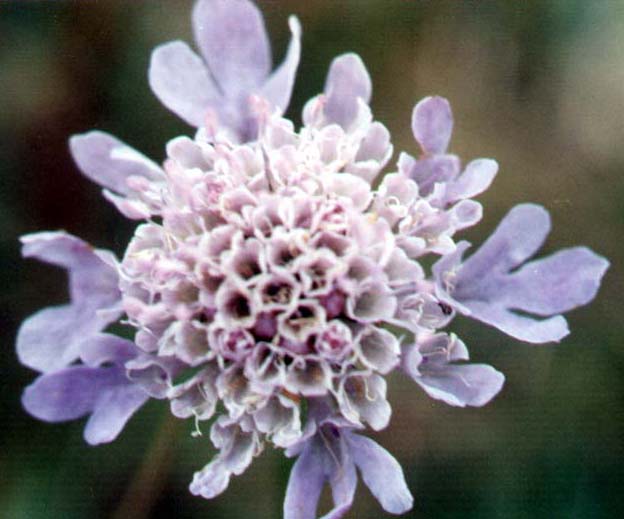 |
|
|
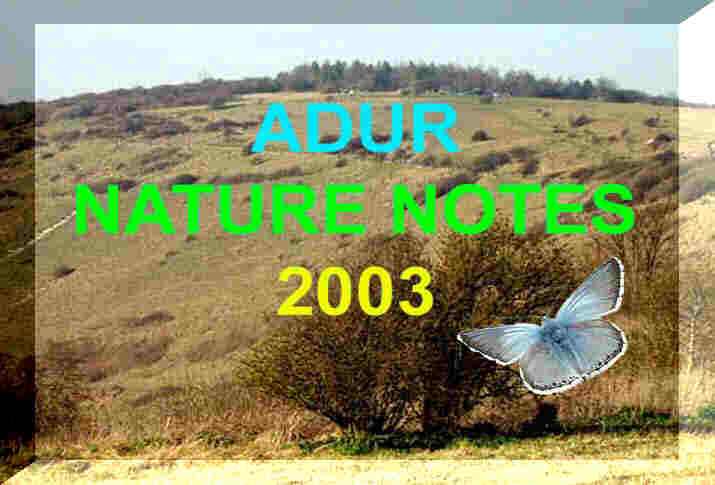 |
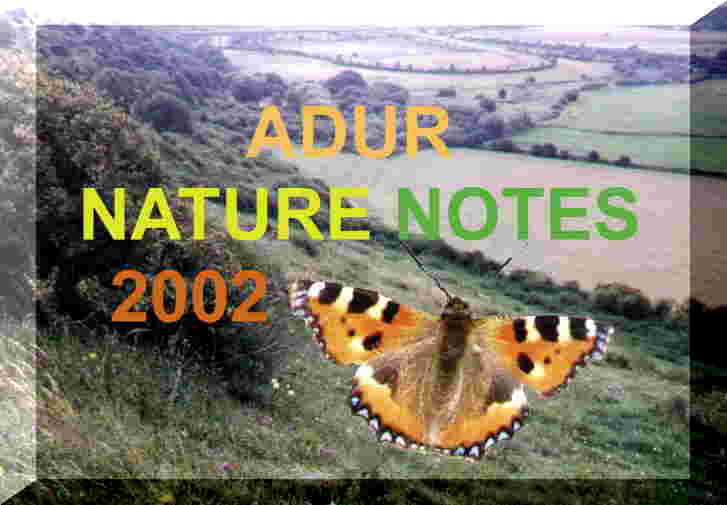 |
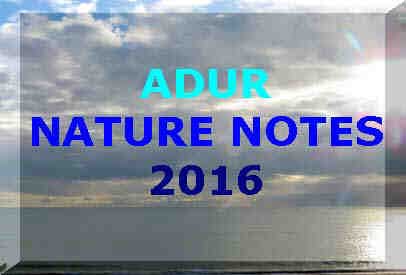 |
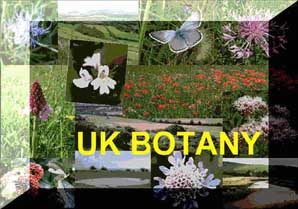 |
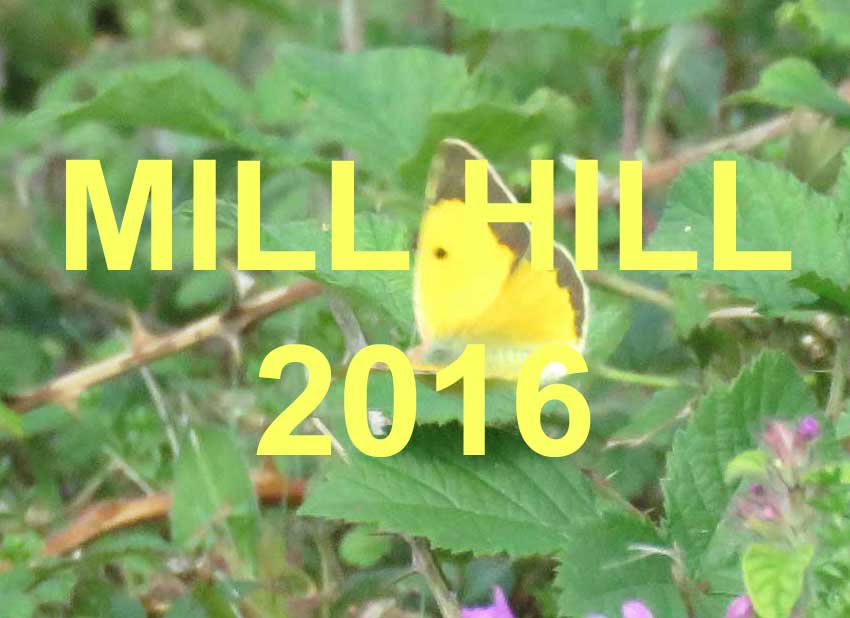 |
| Adur Flood Plain |
| Chalk Downs |
| Coastal Fringe |
| Intertidal (Seashore) |
| River Adur Estuary |
| River Adur Flood Plain |
| Sea (off Sussex) |
| Town & Gardens |
| Widewater Lagoon |
|
|
South
Downs: Beeding Hill
including
Anchor Bottom and meadows
Beeding Hill the high point on the downs near Shoreham is 169 metres (554 feet) above sea level.Wild Flower Gallery
Photographs by Andy Horton
Harebell Small Scabious Greater Knapweed Kidney Vetch
Cycling Route to Mill Hill
Friends of Lancing Ring (External Link)Downs around the Adur Valley (under construction September 2000)
CLICK ON THIS TEXT FOR THE 2004 REPORTS
3 October 2003
Flying over the derelict Cement Works at Upper Beeding, I thought I spotted a large black corvid, maybe the grey/silver face of a Rook, which seems to be unusual (or overlooked by me) in the lower Adur valley. The Rook is classed as "very common resident" by the Sussex Ornithological Society. The Shoreham & District Ornithological Society has identified local rookeries.6 July 2003
Late in the afternoon whilst cycling on the bridleway to the south east
of Beeding Hill, I heard one male Quail calling very distantly to the south
west. (TQ 220 093)Report from Dave Green on Sussex Ornithological Society News
14 June 2003As I climbed the steep path from the South Downs Way Footbridge over the Adur to Beeding Hill I heard the Skylarks in song and saw their familiar outlines in the sky. Small Tortoiseshell Butterflies increased in frequency and I must have spotted 30 but some could be the same butterfly following me. There was just a solitary faded Painted Lady Butterfly that landed in front of me.
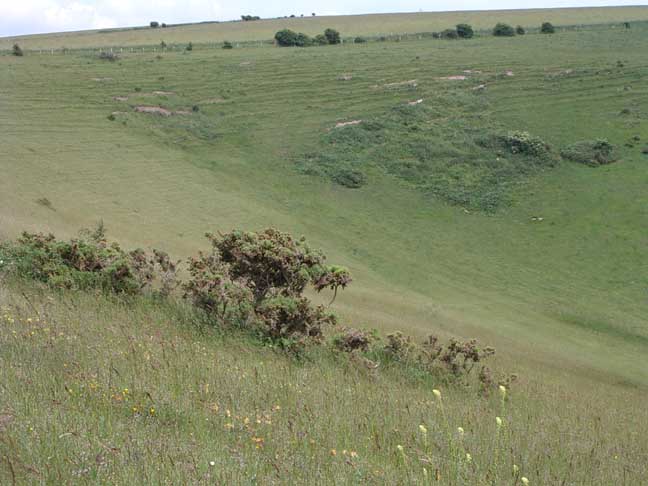
Top half of Anchor Bottom (near Beeding Hill) from the meadow to the NE
The photograph above shows the grazed meadow that contained a few battered Pyramid Orchids, Anacamptis pyramidalis, and a handful of better condition Fragrant Orchids, Gymnadenia conopsea. Kidney Vetch, Anthyllis vulneraria, was noticeable.
On the roadside verges at the top of the hill in the picture, I saw a handful of the first Meadow Brown Butterflies of 2003.
22 April 2003
A Pheasant was feeding in a stubble field (west side) on the way up to Beeding Hill from Mill Hill.20 April 2003
A Dingy Skipper Butterfly was seen by the side of the Industrial Estate at Golding Barn near Upper Beeding (near Steyning) in the Adur valley on a breezy overcast Easter Sunday morning. This species is not often recorded, although it it is known from Mill Hill.Report by Jim Steedman via the UK-Leps EForum19 October 2002
Six Small Tortoiseshell Butterflies were seen between Beeding Hill and Truleigh Hill.Report by Allen Pollard via the UK-Leps EForum31 August 2001
On an overcast day, following a shower, a Small Copper Butterfly (probably) was seen at Beeding Hill flying rapidly over towards Anchor Bottom, skirting the hedgerows on the bumpy lane down to Castletown, where a Speckled Wood Butterfly in reasonably good condition settled.
12 September 2000
A few female Common Blue Butterflies were seen near Beeding Hill.
This is a female Common Blue. The white flecks on the wings are typical of female Common Blues found on calcareous soils. Andrew Daw.Three or four species of Dragonflies hawked/darted over the Downs. In order of frequency, they appear to be (subject to confirmation):
Emperor Dragonfly (? ID) (frequent 30+) Anax imperator
(Some of these could have been the Migrant Hawker, Aeshna mixtaon reflection. However, despite the late in the year flying time, the size of the Emperor should make them unmistakable, but they have been confused with Southern Hawkers, Aeshna cyanea.)
Common Darter (very frequent 70+) Sympetrum striolatum
(Some were blue-grey the others orange-brown and red)
British Dragonfly Society
UK Dragonflies Yahoo Group
Adur Damselflies & Dragonflies
European Dragonflies Picture Gallery11 June 2000
Martin Davies surprised a Roe Deer when cycling between Truleigh Hill and New Erringham Farm over the downs route to Mill Hill. It was in the arable field on the east side near Beeding Hill.
South
Downs (AONBs)
South
Downs: Chalk Cliffs (pic.)
View
of the downs north of Mill Hill from the River Adur valley (Link)
Coombes (the other side of the valley)
85 million years ago, Cretaceous Period (144 - 66.4 million years ago): Sussex is covered by a warm sea inhabited by ammonites, Micraster and other urchins, molluscs, at a lower latitude (Continental Drift: Tectonic Plate Theory). Sedimentary deposits of foraminiferans such as Globigerina and coccoliths (microscopic plankton with a calcium carbonate shell) lay down the chalk (Pic) which is rock of the South Downs near Shoreham.
Wayfaring Tree
The Wayfaring Tree is well named as it is found beside footpaths and old sheep trails, possibly thriving on the extra nutrients in the sheep's latrine.
(It
is not easy to explain the steepness of the eastern and western boundaries
of the Adur Valley cutting through the South Downs north of Shoreham, although
they may have been created by melt water and weathering in periglacial
times).
Explanation
(in the course of completion: at first draft stage)
See
Devil's
Dyke South Downs site
South
Downs AONBs (Countryside Agency)
South
Downs (Friends of the Earth)
South
Downs Way
Countryside
Agency
Council
for National Parks
East
Sussex Ecology Page
Sussex downland AONBs = 981
sq. km.
Butterflies:
Small Tortoiseshell Aglais urticae Clouded Yellow Colias croceus Meadow Brown Maniola jurtina Marbled White Melanargia galathea Large White Pieris brassicae Gatekeeper Pyronia tithonus Speckled Wood Pararge aegeria Small Copper Lycaena phlaes Painted Lady Vanessa cardui
Common Blues on Chalk Downsfrom "Andrew Daw" <andrew.daw@zuken.co.uk>
Subject: RE: New file uploaded to uk-leps (photograph above)Hello,
This is a female Common Blue. The white flecks on the wings are typical of female Common Blues found on calcareous soils (Chalk, limestone, ...).
The amount of blue on the wings vary from butterfly to butterfly,
even in the same colony. The extremes in the range (totally blue,
or totally brown) are not so common.Andrew
> -----Original Message-----
> From: uk-leps@egroups.com
The Common Blue caterpillar feeds on Bird's Foot Trefoil.
.
- Local
Wildlife Links (SE England)
Adur
& the Downs: Protected Sites
Adur
Valley Nature Notes 2002
Adur
Valley Wildlife
Butterfly
Conservation Society
Chalk
& Flint Link
Dungeness,
Kent, England
Lancing
Ring
Orford
Ness: Coastal Ecology of a Shingle Bank (excellent references)
Ralph
Hollins Nature Pages (Chichester Harbour area)
Rye
Harbour Nature Reserve
Rockpooling
Page
Seashore
Page
Shingle
Coast (Coastal Fringe of Shoreham Beach)
Shoreham-by-Sea
Wildlife Page
South
Downs History (External) site
South
Downs Way (by Allen Pollard)
Southwick
Hill
Sussex
Archaeological Society
Sussex
Archaeological Society EGroup
Sussex
Archaeology & Folklore
Sussex
Wildlife Web Sites
UK
Dragonflies Discussion Group
UK-LEPS
Discussion Group (for Butterflies and Moths)
Lancing
Ring & Mill Hill Information 1 (requires Acrobat Reader)
Lancing
Ring & Mill Hill Information 2 (requires Acrobat Reader)
|
|
|
|
|

